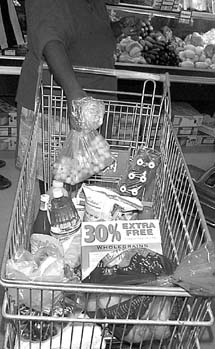Good health starts at the checkout
John Tregenza worked with Anangu Pitjantjatjara
Services on a study to determine the cost of
healthy living. This is what he found ...
One of the underlying problems is the obvious connection between health
status and people in communities and the amount of disposable income
that they have and the store prices that they're confronted with for
their daily sustenance. On behalf of one of the regional councils we
completed an incomes and expenditure study for them so we could actually
come up with some hard data on peoples' living situation.
The thrust of our work was to see whether people could access these
healthy living items to remain healthy, because we are confronted with
ever increasing lifestyle diseases like kidney failure, hypertension,
heart attack and all sorts of diseases which are directly related to
accessing the healthy living box.
We designed a food and health box consisting of three categories:
(1) Food for a family of six which was calculated by a nutritionist
in Alice Springs. We costed it out for a family of six over a week.
(2) We had a category of health hardware, things that you need to be
healthy in the house like brooms, mops, buckets, cups, pannikins, tin
plates, saucepans, a tuckerbox, an esky.
Just basics; a swag, blankets, things like that for one year's use.
We were very light on - no white goods, no electrical items, no fridges,
washing machines or anything like that.
(3) The last category was health consumables. All the things that people
need to keep healthy like soaps, shampoos, disinfectants, detergents,
all of those sorts of things. So we added up the costs for a week, then
we surveyed ten stores on the lands and we got an individual price for
each community for that box of goods and also a mean figure across the
lands.
Then on the other side of the ledger, we examined peoples' incomes in
the area that we were looking at. Eighty five percent of the adults
income is from welfare or CDEP and some community wages. Communities
authorised us to access them.
The other fifteen percent of wages that we couldn't access, although
asked, were from government departments like police and education. When
we added it all up, for the family of six, we took into account the
CDEP payments to adults as two of the six, a fully paid pension being
one of the others and three children who we calculated as receiving
the family assistance allowances.
We took the maximum income and then we deducted from that income rent,
power and other levies that are charged by communities. Not a lot of
people are aware of this but most people pay rent, they pay for their
power and some pay for water.
Then there are all sorts of other levies like community debts, funeral
levies and other things. We worked out the families' net income then
we matched it to the cost of the healthy items in the store and across
the lands, right across the area we were looking at for all of the people
we found that for that family to be healthy they had to spend eighty
five percent of their total income on healthy living items.
That's even when you've got your maximised income. We took that position
because we wanted to see the best case scenario, although we know that
most people don't have full incomes. There are all sorts of problems
with not working full hours, not being around, pensions not catching
up with people.
Eighty five percent of peoples' incomes in these communities has to
be spent on those healthy living items just to be healthy.
The equivalent in non-aboriginal society, in communities with people
on a similar sort of income, those who are welfare recipients, spend
forty percent of their total income on the same items.
So, Aboriginal people are spending eighty five percent of their total
disposable income. So, it's a very big ask, in fact it's an impossibility!
Not surprisingly it doesn't happen because most people haven't got full
incomes and all the health items are not available. No community has
everything available - some communities are better than others.
One of the other issues we looked at is the distribution of income.
I should point out that none of those healthy items included anything
like cigarettes, sweets, cool drink, bullets, petrol.
None of those luxury items were included. The only items were those
needed basically to stay alive and be healthy. The conclusion is that
it's an impossibility for Aboriginal families on remote communities
to remain healthy in this situation.
We contend that it doesn't matter who you are - in this situation you
can't manage, and as a consequence you can't be healthy.
We concluded that until something's done to address the fundamental
nexus that people are in, where they cannot financially remain healthy,
well then the health sector of the communities and of Australia for
that matter is always going to have an ever-increasing burden.
We can safely say from those figures that children born today in those
communities are not going to be healthy because it's actually impossible
for them to be healthy. They are therefore going to be clients for the
medical sector.
The question being asked now is: if you were to subsidise healthy food,
the cost of that subsidy would perhaps not be more than the cost of
the increased medical cost that you have to pay down the track?
This has been discussed by the local Aboriginal councils. There are
only two factors involved: one is income and one is expenditure. There
are three options. You can leave things as they are, you can reduce
expenditure costs or you can increase incomes.
To leave things as they are is to condemn people to permanent ill health.
We don't consider you achieve the health outcomes if you raise peoples'
incomes, necessarily, because you can't guarantee that the raised income
is spent on the identified health items. Also, in these communities,
there's in fact no way of raising peoples' incomes. It's fixed by external
forces - CDEP and welfare. So, we can't really change the income.
To change the situation we have to change the costs of those items and
the only way to do it at the moment, we contend, is by subsidising those
items.
The policy actually being adopted by the council for the region is to
investigate subsidising and then retailing identified health items at
a fixed price. That price can be calculated as some percentage of peoples'
disposable income.
We're recommending that, in the first instance, they seek subsidisation
up to the items costing fifty percent of peoples' income - if they were
able to access the healthy living box.
Part of the strategy to deal with making good food available at affordable
prices is to tackle the philosophy of community stores. They've always
been categorised by government departments as enterprises. We challenge
that.
We say that they are not enterprises, they're services. They're not
enterprises because they exist in a monopoly situation, they have a
fixed amount of potential custom. Once the mail plane, the pay plane
or truck or whatever leaves, there's a fixed amount of money available.
What doesn't leak out from the community, which we've found to be about
thirty percent across the board, will be spent in the store. So, it's
in no sense a commercial enterprise.
There's no way of actually ever increasing its profit except by raising
prices and making people pay more for the same items. So, that's not
enterprising at all. I refer to that as a direct tax upon the poor.
Moreover this situation is being encouraged by government departments
who, when the communities have experienced reduction in funding for
community infrastructure, are encouraged to fund it from their store
profits.
This is a really insidious suggestion because all it's doing is further
taxing the people who are already unable to afford to be healthy. Making
profits out of services like that is simply making people pay more for
the same amount of food. This just adds to their health burden of course.
We need to ensure that community stores are part of the health service.
They're there to deliver nutritional food and health items to the community.
It's not important that they make a profit because, in fact, services
of this kind usually don't make a profit -they are a service, they require,
therefore, subsidisation.
It's far cheaper to do what ever is necessary to keep people out of
hospital than to merely support the tertiary end of health care which
is the hospital system.

John Tregenza

